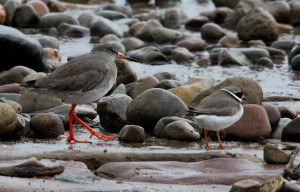The se a at Rockfield, on the east coast just south of Tarbat Ness looked so calm it was almost like a large loch as there was scarcely a ripple on the surface. The tide was well out and most birds there were resting on the well exposed rocks. At the end of the slipway were two groups of waders and one was turnstones and I wondered where they came from. They are likely to have bred this summer in Greenland or Canada and come here to moult and stay the winter. The other tightly packed group were ringed plovers, with one solitary redshank, and these are more likely to be birds that have bred in the Highlands and moved to the coast for the winter months. There were even smaller numbers of curlews and oystercatchers and the only true seabird was a cormorant fishing in the shallow water, with some success, around the rocks. The bird caught two fish whilst I was watching it and each about six inches long and there was a lot of juggling before the fish went down, head first.
a at Rockfield, on the east coast just south of Tarbat Ness looked so calm it was almost like a large loch as there was scarcely a ripple on the surface. The tide was well out and most birds there were resting on the well exposed rocks. At the end of the slipway were two groups of waders and one was turnstones and I wondered where they came from. They are likely to have bred this summer in Greenland or Canada and come here to moult and stay the winter. The other tightly packed group were ringed plovers, with one solitary redshank, and these are more likely to be birds that have bred in the Highlands and moved to the coast for the winter months. There were even smaller numbers of curlews and oystercatchers and the only true seabird was a cormorant fishing in the shallow water, with some success, around the rocks. The bird caught two fish whilst I was watching it and each about six inches long and there was a lot of juggling before the fish went down, head first.
Then what I call “true seabirds” appeared as out from the rocky shoreline were three gannets slowly moving south. Their progress was slow as they were fishing and spiralling around until they saw something and then made that headlong dive. Even without binoculars I could see the almost startling white plumes of spray as the gannets hit the water. Two of the birds were adults with their very wide wingspans looking very impressive. What seemed to add to the overall size of the birds were the impressive black tips to the wings. The juvenile bird was very dark, looking black from a distance, and it was almost certainly a bird hatched this year. It could have come from any of the gannetries along the north coast, such as Sula Sgeir, or even the west coast such as St.Kilda. Now the juvenile would wander the seas until going back to breed in three or four year’s time.
The seaducks were given away by a small group of very agitated herring gulls that were circling very low over the sea and then suddenly diving down as if for food. Below them were a male and female eider feeding and they were rapidly diving for shellfish, such as mussels, which is their main diet. The gulls would be scavenging, as gulls do, and picking up any small piece of shells or flesh that floated to the surface from the eider’s feeding. It is unusual to see just a pair of eiders at this time of the year as they are normally building up to their winter flocks. Perhaps the pair had lost their clutch of eggs or ducklings to predators such as mink or gulls let alone crows. Eiders nest on the ground with the female doing the incubating and relying on her camouflage to avoid predation.
Whilst all the birds over the sea or on the rocks were very interesting there was also something fascinating around me. I was sat in a large area of marram grass with an old pile of well used lobster pots. I might just as well have been in the garden at home for the birds I could see there. There were at least three robins and plenty of house sparrows. A group of starlings fed on grassland and the scene was completed by a three pied wagtails, two dunnocks and a blue tits.
Tags: highland wildlife
